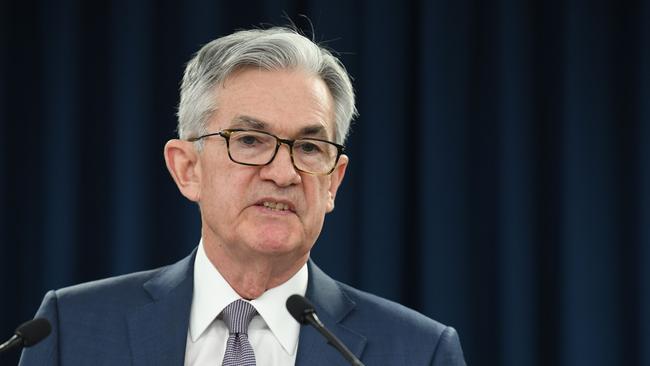Bulls stir in April share boom
A flood of central bank liquidity is overwhelming concern about the economic impact of coronavirus lockdowns.

A flood of central bank liquidity is overwhelming concern about the economic impact of coronavirus lockdowns and the risks associated with plans to end them sooner than expected.
Along with massive fiscal policy stimulus and expectations of more to come in the US, some progress towards medical treatments for the virus and slowing numbers of infections and deaths, the money thrown at global markets by the Federal Reserve in particular is giving a major boost to share prices.
In Australia, as in the US, this has taken bears to the point of capitulation, where the pain is too great to stay short and the fear of missing out on what could be a further large rise driven by central bank liquidity leads investors to buy any dips or even buy on a further rise in the market.
After falling 21 per cent in March — its worst month since the October 1987 crash — Australia’s S&P/ASX 200 share index rose 8.8 per cent in April, its best month since inception in 2000.
The All Ordinaries index rose 9.5 per cent, its best month since March 1988.
And with the US dollar falling amid a deluge of central bank supply to prevent a credit crunch, offshore investors in Australia enjoyed an additional 6.7 per cent tailwind from the exchange rate.
The S&P 500 was on track for a 13.7 per cent rise which would be its best month since 1974.
That follows a 20 per cent fall in the March quarter, which was its worst quarter since 2008.
Both indexes have been back in technical bull markets for some weeks.
While the Fed didn’t add any more stimulus after its meeting this week, chairman Jerome Powell made it abundantly clear that the world’s most powerful central bank will err on the side of caution.
“The Fed is committed to using its full range of tools to support the US economy in this challenging time, thereby promoting its maximum employment and price stability goals,” he said.
“The ongoing public health crisis will weigh heavily on economic activity, employment and inflation in the near term, and poses considerable risks to the economic outlook over the medium term.”
It plans to keep rates near zero until it is “confident that the economy has weathered recent events and is “on track to achieve its maximum employment and price stability goals”, buy US Treasury bonds, agency residential and commercial mortgage-backed securities “in the amounts needed to support smooth market functioning”, and continue to offer large-scale overnight loans and repos.
BlackRock CIO of global fixed income Rick Rieder says the overarching theme of the latest Fed meeting — its first non-emergency meeting since February — was that it was committed to do “whatever it takes and more, just to make sure as strong as possible a recovery can be re-established”.
When the Fed chair said on October 3, 2018, “we’re a long way from neutral” on US monetary policy, BlackRock’s bond guru simply tweeted: “#fedpause”.
The rest is history as the Fed roiled markets with a final rate hike in December of that year before abandoning its long-held plan for further rate hikes altogether in early 2019.
The Fed started cutting rates in response to the economic downturn later in 2019, then cut rates to zero and adopted unlimited quantitative easing in response to the COVID-19 crisis in March.
Now, Rieder says the scale of the Fed’s policy response is “simply stunning”.
The implications of this unprecedented flood of liquidity are very bullish.
The scale of the Fed’s asset buying and the way it expanded and broadened its buying even as the US sharemarket surged suggest it aims to inflate the market to reverse the tightening of financial conditions and thereby remove a negative wealth effect. Rieder expects the Fed to buy the equivalent of at least $US1.5 trillion ($2.3 trillion) in Treasuries over the remainder of the year, or about $US200bn per month.
“With asset purchasing in roughly these amounts, as well as everything the Fed has already done, the magnitude of the policy response to this economic crisis is simply stunning,” Rieder says.
For context, from the founding of the Federal Reserve at the end of 1913 until 2008, or roughly 95 years, the central bank’s balance sheet grew from essentially $US0 to $US900bn.
Yet in response to the global financial crisis, from 2008 through 2014 (via QE1, QE2 and QE3), the Fed’s balance sheet grew fourfold to $US4.5 trillion, a pace of roughly $US3bn per day.
“By year end, we anticipate the Fed’s balance sheet will have grown by a staggering $US7 trillion in an effort to deal with the fallout of the coronavirus crisis, or at a pace of nearly $US26bn per day,” Rieder says.
Fed asset purchases through year-end will equate to nearly one-third of US GDP, and the total Fed balance sheet at year-end is likely to reach more than half the size of the US economy.
“The policy response has been monumental and highlights the Fed’s determination to not lose this battle,” Rieder says.




To join the conversation, please log in. Don't have an account? Register
Join the conversation, you are commenting as Logout